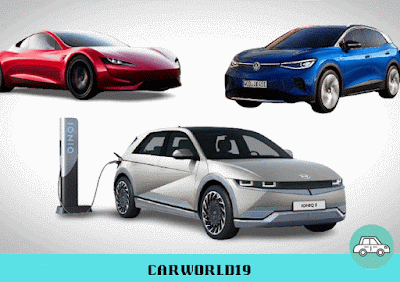People are getting increasingly interested in electric automobiles (EVs). They dread planning for petrol prices and are concerned about the impact of automobiles that are fuel-dependent, for example. Some people are also enthusiastic about being early adopters of new technologies.
They like electric vehicles because they allow them to be on the cutting edge of technology.
 |
| What Are the Most Popular Electric Vehicles? |
The Different Types of Electric Vehicle Motors
There are two types of electric motors that are often seen in EVs. Let's have a look at them now.
Asynchronous Motors (sometimes known as synchronous motors) are electric
- Asynchronous motors, often known as induction motors, use electrically driven stators to generate spinning magnetic fields. Within the engine, a stator is a coiled wire. It has a shaft with a magnet on it. The magnet creates an alternating current as it rotates.
- The resultant magnetic field pushes the rotors in the vicinity, causing them to spin. This motion generates the energy needed to spin the car's gears and, eventually, its wheels. Engineers frequently select these EV motors for cars that will be driven at high speeds for extended periods.
Motors that are synchronized
The rotor of a synchronous motor acts as an electromagnet and generates a magnetic field. In an induction motor, the stator fields rotate faster than the rotor, but in a synchronous motor, the rotor and stator rotate at the same speed. The total speed is determined by the frequency of the current that drives the motor.
Synchronous motors are commonly seen in electric cars aimed at urban drivers. This is because they're well-suited to frequent stops and starting at lower speeds, like someone could do during rush hour.
Electric motors: How Reliable Are They?
Electric motors are used in a variety of sectors that demand continuous operation from machinery, even though electric cars are still relatively new.
Hundreds of pieces work together to ensure the operation of some industrial electric motors. Temperature, humidity, and excessive dust are all factors that might reduce the life of an industrial electric motor. However, as a preventative step, firm executives usually test the components regularly.
The armature, which is the component holding the coils, is the major moving portion of an electric vehicle. The majority of these warranties are based on the amount of time spent driving the car. Depending on the measure used in your area, you can find warranties ranging from 80,000 to 100,000 kilometers or miles.
The Different Types of Electric Vehicle Motors
Brushless asynchronous induction motors, brushed externally excited synchronous motors, and brushless permanent magnet synchronous motors are the three types of electric motors most often used in electric vehicles.
Permanent Magnet with No Brush Motors that are synchronized
Permanent magnet with no brushes In the same way as induction motors have stators and rotors, synchronous motors have as well. The rotor also contains rare-earth elements such as neodymium and dysprosium. These are ferromagnetic materials, which can be magnetized indefinitely.
The stator's electromagnetic is activated in sequence by a controller, generating a magnetic field that rotates around the rotor. The rotor's magnetic fields then strive to keep up with the rotating field at the same pace it rotates, thus the name "synchronous." The rotor spins as a result of these activities.
This is the most prevalent type of EV motor, and it can be found in cars like the Nissan Leaf and vehicles with self-driving capabilities like the Tesla Model 3. Many individuals believe that self-driving cars will transform our civilization by increasing mobility alternatives while decreasing car ownership.
Asynchronous Induction Motors with No Brushes
Electromagnetic coils serve as stators and rotors in this sort of motor. The magnetic fields of the stator produce an electric current and a magnetic field in the rotor's windings as they revolve. When the stator fields revolve slightly faster than the rotor, this occurs.
This sort of motor may be found in electric vehicles such as the Tesla Model S. This type of induction motor is also used in high-performance automobiles since it can provide greater power than magnet-based motors.
However, the magnet-type synchronous motors explained previously have the benefit of being more efficient than induction motors. This is because the magnetic field may be created without the usage of energy. Magnets are constantly turned on. Magnet-type motors are frequently used by designers for smaller and lighter autos.
Synchronous Motors with Brushed External Excitation
These motors, like induction motors, contain stators and rotors, but the rotors are connected to a DC power supply through a spinning electrical contact called a slip ring. This method provides a magnetic field, allowing these motors to perform similarly to permanent magnet motors.
One car that employs this technology is the Renault Zoe. Rare-earth metals are mostly produced in China, and manufacturers are having growing trouble obtaining them for permanent magnet motors. There is an ongoing effort to develop motors that perform similarly to those choices but do not require the use of specific metals.
One option is to use externally exciting types. As they become more widely available, you expect to see them in automobiles that formerly utilized permanent magnet motors.
Electric vehicles are part of a larger picture
People don't just consider the electric motors in the models on their shortlists when shopping for electric vehicles. Battery life, charging time, safety features, and driver aid choices are also important to them.
This analysis, however, demonstrates that electric motors are critical components of today's electric cars. Each kind works distinctly and delivers performance that is best suited to a certain application. As a result, if you're considering buying an electric car soon or working on a project using them, knowing how the function of the motor is critical to achieving favorable results.



I found decent information in your article. I am impressed with how nicely you described this subject, It is a gainful article for us. Thanks for share it.Electric Vehicle Charging Station
ReplyDelete